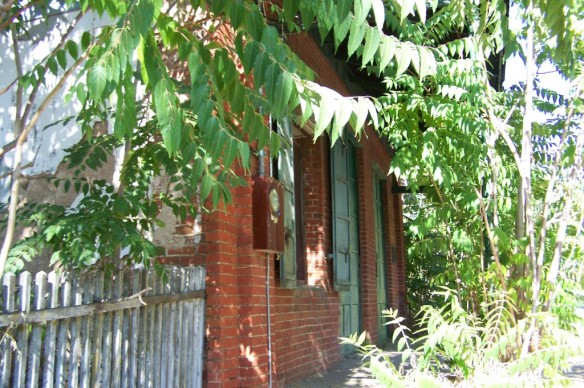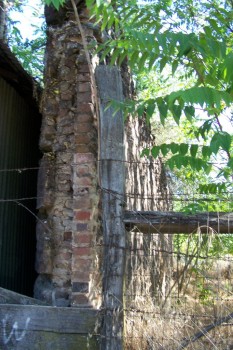Chinese Camp

Some buildings dating back to 1850's stand vacant and silent as you see in this photo of the post office established in 1854. Photo: Sandy Gordon
Chinese Camp is located along Highway 120/49 south of Jamestown at an elevation of 1, 299 feet. It is one of the smallest towns in Tuolumne County with a population of only 126, which makes it a candidate for ghost town status on MANY websites and travel guide books.
Because of its name, people are surprised that no Chinese have lived in the town since about 1930. The schoolhouse was constructed to look like a Chinese Pagoda, but it is no longer being utilized. The only business left in Chinese Camp is a store, tavern and some small cabins nearby.
In its heyday Chinese Camp was a transportation and entertainment center along the main thoroughfare for the Sonora-Big Oak Flat (Groveland) route. It was a major stagecoach stop as well. The railway was just north of the town.
One of the little known facts about Chinese Camp is the St. Francis Xavier Catholic Church, which is located halfway up Rocky Hill on the east side of Highway 120/49 was built in 1855 and is one of the first 10 churches in Tuolumne County and is one of the oldest surviving Roman Catholic church buildings in the county (after St. Anne’s in Columbia). Services have not been held in the church since the 1920s. Around the building is a cemetery with several of the family plots surrounded by ornamental iron fences. The earliest legible death date is 1862 of those stones still standing.
 Apparently, in 1849, some Englishmen moved into an area called Campo Salvador just over the hill from Chinese Camp. In their employ were several Chinese laborers. Apparently, the Englishmen found gold and although there wasn’t a source of water close-by, there was enough. The Americans in the surrounding area, became jealous of the English company’s success which resulted in a race riot that drove off the Chinese laborers. The English left in despair, returning to Stockton around March 1850. Meanwhile the Chinese were merely over the hill in the northwest corner of Chinese Camp settling down on land that nobody was claiming at the time.
Apparently, in 1849, some Englishmen moved into an area called Campo Salvador just over the hill from Chinese Camp. In their employ were several Chinese laborers. Apparently, the Englishmen found gold and although there wasn’t a source of water close-by, there was enough. The Americans in the surrounding area, became jealous of the English company’s success which resulted in a race riot that drove off the Chinese laborers. The English left in despair, returning to Stockton around March 1850. Meanwhile the Chinese were merely over the hill in the northwest corner of Chinese Camp settling down on land that nobody was claiming at the time.
They applied their training at mining placer gold and were soon discovering gold. They salvaged foodstuffs and other supplies from the failed English endeavor. With the junction of trails leading to various mining centers Chinese Camp was established as a trading and transport center. On April 13, 1850, the first U.S. Census of Chinese Camp found a population of 168 white men. Of course in those times, Chinese (usually referred to as John Chinamen) were not considered worthy to be counted as they couldn’t vote. In 1850, there were only 19 recorded Chinese. Of course, they were probably seriously undercounted and in Chinese Camp, not counted at all.
In 1850, William and Martin Walkerly set up their general store which became the largest and most famous store in Chinese Camp. On December 26, 1850, miner John Dart wrote, “I have been around the Chinese Diggins nearly two months doing nothing, waiting for rain. There is about 1,000 people in this camp, and some five or six are women.”
In 1851, Kwong Wo was the first Chinese child born in Tuolumne County. He probably lived in Chinese Camp as there was evidence he lived there in later years.
Between 1850 and 1856, Chinese Camp developed as a commercial center while mining continued (about $2.5 million in gold was taken out). In 1860, 195 Chinese were recorded as being in Chinese Camp; however, there were 18 general merchants, 10 boardinghouse keepers, six cooks, seven doctors, three saloon keepers, six butchers, four bakers, two grocers, two clerks, two tailors, two barbers, a washman with two female helpers, and one musician. It seems likely that these various entrepreneurs were serving a far larger population than that reported in the town by the census-taker. It does go to prove a story that Chinese Camp was the headquarters or distribution center for Chinese goods and services in the Southern Mines. The Chinese Camp post office was established April 18, 1854.
The most legendary event of Chinese Camp was the so-called Tong War which took place October 25, 1856. It is reputed to be the first Tong War in California. The fight was the result of a mining dispute between two rival Chinese associations. The battle was arranged to take place in a nearly level field across La Grange Road from the Crimea House and its corral. There were few casualties. Deputy Sheriff John Roberts confiscated a stack of firearms, but he eventually returned them. It’s reported that the blacksmith, also kept some of the “Tong War” weapons and armor which are said to have been donated for scrap in World War I.
The closing of the last stage line around 1914 and the coming of the automobile ended Chinese Camp’s economic use as a transportation center. Many fires also contributed to Chinese Camp’s decline. With decreasing population and business, it was not rebuilt after the last major fire in 1918. The Chinese population also disappeared. Once the roads and the railroads had been built, there was no longer a call for their labor. Mining had long since ceased to pay. It’s said that most of the Chinese departed in 1918 and that the last one left in 1925. After that Chinese Camp became today’s quiet small ranching community.
Here are websites that offer more history and photographs of Chinese Camp:
http://www.yosemite.ca.us/library/big_oak_flat_road/chinese_camp.html
http://www.ghosttowns.com/states/ca/chinese.html
Historic research by Dolores Nicolini

Join our list to stay up to date on specials and events in Tuolumne County!

